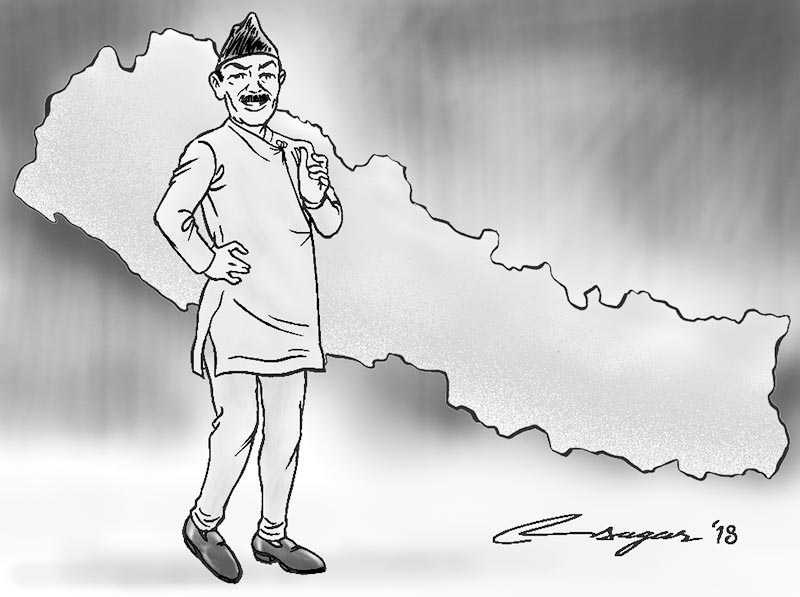Daura and Suruwal: Their history & journey
Daura Suruwal and its journey have been traced back to Peshawar, Kashmir to Nepal through Afghanistan. The Daura-Suruwal-Topi combination has been designed and redesigned through generations out of various needs and style
It is rather difficult to trace the exact origins of the Daura Suruwal, a garment that seems to be heavily derived from both central Asian and Middle Eastern clothing culture. Its origins can be traced back to the mountain of Hindukush of Tajikistan in regard to its designing and developments.
Daura, also referred to as Labeda, is worn on the upper half of the body as a tunic. Consisting of eight pattern blocks, it is constructed using four ties; two slightly above the chest near the shoulders, and two near the waist. Suruwal, on the other hand, translates to pajama in Nepali.
Its pattern and construction is similar to that of a churidar pajama; the volume on the waist tapering down towards the ankles. Usually a nada is used to pull and bunch the fabric at the waist, although using an elastic strip has become a common practice.
A coat and the Bhadgaule topi or the Dhaka topi is essential to complete the Nepali look.
Daura Suruwal and its journey has been traced back to Peshawar, Kashmir to Nepal through Afghanistan.
The most notable clue regarding this is the Karakul hat worn by former Afghan president Hamid Karzai which bears an uncanny resemblance to the Nepali topi.
The Daura-Suruwal-Topi was brought along by Khash migrations from the mountains of Caucasian of central Asia, through Hindu Kush, and ultimately to the north western Himalayas of Nepal.
Settling on the high hills and valleys such as Jumla, Humla, Bajura and Bajhang districts of North West Nepal, they adopted overlapping double breasted tunics to keep their bodies warm from the cold climatic conditions of the Himalayas.
It is also not difficult to notice the Central Asian influence. The Mongolian, Chinese and Tibetan cultures have been known to wear overlapping garments of various lengths and thickness. The Kiratis have donned overlapping double breasted upper garments.
The mandatory Patuki, before the arrival of the coat and waistcoat, helped turn the upper portion into a large pocket making it especially easy to carry and conceal the Nepali weapon of choice, Khukuri.
Suruwal on the other hand is simple to stitch, volume on the waist providing simple solution for various waist sizes. Several extra inches are cut when deciding the length of the suruwal.
The Malla Kings of Nepal were religious and were apt practitioners of the tantric sect of Hinduism and Buddhism. It is during the reign of the Malla dynasty that the Daura Suruwal achieved religious attributions.
Daura has eight strings, as eight is regarded to be an auspicious number, which are referred to as Astamatrika-Singini.
It serves to tie daura around the body. Daura has five pleats or Kallis, signifying Pancha Buddha or Pancha Ratna.
Under the Mallas, daura suruwal became a status symbol for people holding offices. Daura suruwal of this time was similar to the angrakha of India in terms of length and volume, with a waist seam for added fullness. Patuki, a piece of fabric roughly five metres long worn around the waist, was a must.
As we compare Daura Suruwal worn by the monarchs of Nepal, we can observe maximum fullness in that worn by Prithvi Narayan Shah.
The length, however, seems to be shorter when compared to that worn by the Malla Kings. The waist seam and extra fullness gradually decreases and disappears completely by the time of Surendra Bikram Shah.
Various paintings of this era show soldiers dressed in the classic Daura Suruwal which was then referred to as Labeda Suruwal.
The Ranas are credited with the modern take on Daura Suruwal. It is believed that Jang Bahadur Rana received the English jacket as a gift from the Queen of England during his visit.
After he returned from the foreign trip, he ordered all his “Praja” to wear a jacket over Daura Suruwal for all formal occasions. Though not declared the national dress at that time, it was widely accepted as the unwritten formal dress code amongst the aristocrats.
Prime Minister Bir Shamsher Rana declared Daura Suruwal to be the national attire and ordered all common Nepali people to wear it for all formal occasions. Until that time, it is said, commoners were restricted from wearing a suruwal in order to keep the class distinction.
After the fall of the Rana regime, King Tribhuvan continued the tradition of wearing Daura Suruwal, topi and coat combination for all formal occasions.
In 2017 BS, King Mahendra, under his nationalism movement, made Daura Suruwal mandatory for all civil servants.
This cemented the place of the Nepali topi as part of the national costume. The shape, length and volume of the garment remain unchanged.
Few modifications were made during this time period to Daura Suruwal. The only modification as part of his personal style was made by Balkrishna Sama who added the Nehru collar to his daura suruwal.
Daura Suruwal Topi have been designed and redesigned through generations out of various needs and style influences leaving us with a garment that reflects the unique country that is Nepal.






